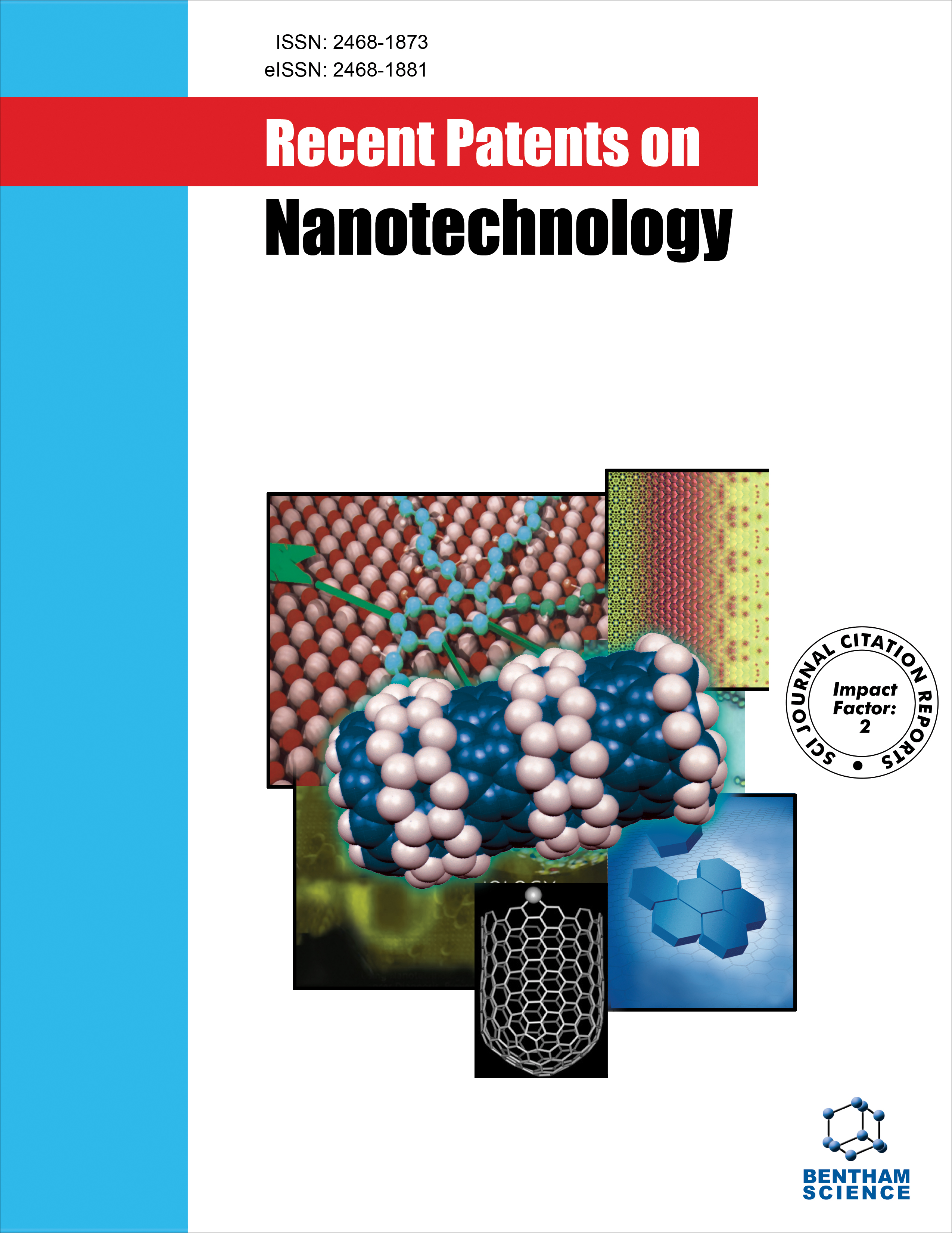- Home
- A-Z Publications
- Recent Patents on Nanotechnology
- Previous Issues
- Volume 19, Issue 2, 2025
Recent Patents on Nanotechnology - Volume 19, Issue 2, 2025
Volume 19, Issue 2, 2025
-
-
Hybrid Nanophotonic Graphene Systems: A Transformative Innovation for Transdermal Drug Delivery
More LessAuthors: Dilpreet Singh and Mandavi PandeyTransdermal Drug Delivery Systems (TDDSs) offer non-invasive administration and sustained drug release, enhancing patient compliance. However, the skin's natural barrier, particularly the stratum corneum, limits the effectiveness of TDDS for high molecular weight and hydrophilic substances. Innovations in material science, particularly hybrid nanophotonic graphene systems, present promising solutions. Nanophotonics genera Read More
-
-
-
A New Approach in the Early Electrochemical Diagnosis of Hepatitis B Virus Infection using Carbon-based Nanomaterials
More LessThe importance of early diagnosis of hepatitis B virus infection to treat and follow up this disease has led to many advances in diagnostic techniques and materials. Conventional diagnostic tests are not very useful, especially in the early stages of infection; it is therefore suggested that nanomaterials can enhance them by changing and strengthening their performance for a more accurate and rapid diagnosis. Electroch Read More
-
-
-
Recent Progression in Nanocarrier based Techniques to Address Fungal Infections and Patent Status in Drug Development Process
More LessAuthors: Ravi Pratap Singh, Raj Kumar Narang and Amrinder SinghFungal infections are becoming one of the most common diseases in recent years, especially when it comes about dealing skin infections. Different drugs are available commercially with antifungal activity for topical application and are effective for treatment of mild to moderate fungal infections. However they lack dermal bioavailability due to their poor penetrability, and less retention at the site thereby resulting in poo Read More
-
-
-
Nanocomposite Hydrogels: An Optimistic Insight Towards the Treatments of Ocular Disorders
More LessAuthors: Shailvi Shah, Riya Patel and Gayatri PatelBackgroundThe distinct anatomy and physiology of the eye represent it as a specialized organ. The noumenal physiological barriers, whose prominent role is to prevent the entrance of extracellular substances, reduce the bioavailability of medicines taken locally. Nanocarriers offer many advantages, such as site-specific drug delivery, reduced dose-related side effects, more drug loading capacity, etc. Nanoparticles, nano Read More
-
-
-
Recent Patents on Solid Dispersions Emphasize Promising Benefits in Solubility Enhancement of Poorly Water-soluble Drugs
More LessAuthors: Manisha Saini, Shailender Bhatt, Harish Dureja and Neeta SolankiBackgroundIn the development of drug delivery systems, drugs' solubility remains the most challenging constraint. Many newly synthesized chemical compounds are available, but they involve low solubility and poor permeability restrictions. Among various drug delivery systems, the utilization of solid dispersion technologies has become more focused due to their promising benefits.ObjectiveThis technology has attrac Read More
-
-
-
A Comprehensive Update on Nanotechnology in Functional Food Developments: Recent Updates, Challenges, and Future Perspectives
More LessAuthors: Sumel Ashique, Shubneesh Kumar, Ekta Sirohi, Afzal Hussain, Arshad Farid, Md. Faiyazuddin, Neeraj Mishra and Ashish GargThe food business makes extensive use of lipophilic bioactive substances derived from plants, such as phytosterols, antimicrobials, antioxidants, ω3 fatty acids, tastes, and countless other constituennts. The preponderance of these bioactive substances, nevertheless, is just about unsolvable in hydric solution and unbalanced at a particular eco-friendly provocation, such as sunlight, temperature, and oxygen, in construction, tran Read More
-
-
-
A Review on the Upgradation of Biomass-derived Hard Carbon Materials
More LessAuthors: Tengrui Wang, Ruyan Li, Qian Liu and Weichi LiuSodium-ion battery is a promising alternative to lithium-ion battery because of its abundant raw material resources, low price, and high specific capacity. Amorphous carbon materials (hard carbon) have micropores and impurities, facilitating the intercalation of sodium ions to form “quasi-metallic sodium,” resulting in a high sodium storage capacity and a low sodium storage potential. Consequently, hard carbon is one of th Read More
-
-
-
Formulation Optimization and Characterization of Solid Lipid Nanoparticles of Apixaban
More LessAuthors: Laukik Mulay, Namita Hegde and Abhishek KanugoBackgroundUnpredictable situations such as clotting of blood, deep vein thrombosis, and pulmonary embolism arise in the body, which is the leading cause of mortality. Such conditions generally arise after surgery as well as after treatment with oral anticoagulant agents. Apixaban is a novel oral anticoagulant widely recommended for the prevention and treatment of strokes and blood clots suffering from nonvalvular at Read More
-
-
-
Analysis of Lanthanum Oxide Based Double-Gate SOI MOSFET using Monte-Carlo Process
More LessIntroductionThis work proposes a Double-Gate (DG) MOSFET with a Single Material made of Silicon On-Insulator (SOI). The Lanthanum Oxide material with a high k-dielectric constant has been used as an interface between two gates and the channel. The Monte Carlo analysis has been used to determine the Conduction Band Energy (Ec) profiles and electron sheet carrier densities (ns) for a Silicon channel thickness (tsi) Read More
-
-
-
Design Optimization and Evaluation of Patented Fast-Dissolving Oral Thin Film of Ambrisentan for the Treatment of Hypertension
More LessBackgroundCardiovascular diseases, including hypertension, are the prominent source of death globally. High blood pressure is responsible for heart failure and also damages the vital organs of the body, which also creates mortality. The activation of the sympathetic nervous system in the primary sunrise period is a highly critical condition, and several persons have lost their tissue due to the unavailability of medicine at this Read More
-
Volumes & issues
-
Volume 19 (2025)
-
Volume 18 (2024)
-
Volume 17 (2023)
-
Volume 16 (2022)
-
Volume 15 (2021)
-
Volume 14 (2020)
-
Volume 13 (2019)
-
Volume 12 (2018)
-
Volume 11 (2017)
-
Volume 10 (2016)
-
Volume 9 (2015)
-
Volume 8 (2014)
-
Volume 7 (2013)
-
Volume 6 (2012)
-
Volume 5 (2011)
-
Volume 4 (2010)
-
Volume 3 (2009)
-
Volume 2 (2008)
-
Volume 1 (2007)
Most Read This Month
Article
content/journals/nanotec
Journal
10
5
false
en


